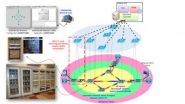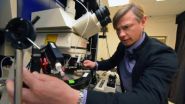(Press-News.org) New software, which will allow GP practice managers to improve healthcare for chronic illnesses including strokes, Alzheimer's and cancer, will be unveiled by scientists from The University of Manchester next week (13 & 14 March). Experts have devised a computer programme which analyses how many patients in a practice have suffered from different conditions over a particular time period and identifies those who might require hospital treatment in the future.
Against a back drop of a drive for NHS efficiency savings, they believe the software will help practice managers to spot patterns earlier and reduce the number of costly hospital admissions for conditions like strokes by providing early intervention treatments. The breakthrough, which is already being trialled at a North West hospital, is one of a number of health innovations going on display at the Europe's largest healthcare innovation event, the Healthcare Innovation Expo 2013, this month (March) held at the ExCeL Centre, London.
The software tool is part of the Greater Manchester Collaboration for Leadership in Applied Health Research and Care (CLAHRC) project. John Ainsworth, a Senior Research Fellow from The University of Manchester's Faculty of Medical and Human Sciences, said the tool could lead to major changes in the way patients with certain conditions were treated. Known as COCPIT (Collaborative Online Care Pathway Investigation Tool), the software lets medics track patient journeys through the healthcare system and identify where care differs from guidelines.
"Our researchers have created an innovative software tool that enables health professionals to better understand the provision of healthcare services and opportunities for quality improvement," Mr Ainsworth, who is also part of the Manchester Academic Health Sciences Centre – a partnership between the University and six NHS Trusts which aims to help implement research and innovation into practice, said. "This will improve healthcare planning by identifying inconsistencies and inequalities in healthcare provision and allow healthcare professionals to specifically focus on illuminating social inequalities in care. The tool will aid assessment of the clinical outcomes and economic impacts of intervention strategies and potential changes to care pathways intended to improve patient care and public health."
Using the tool GPs, health professionals and commissioning organisations explore and analyse electronic health records. The tool allows professionals to:
Identify at-risk patients,
Audit current clinical practice,
Investigate data quality issues,
Explore inequalities in care.
Mr Ainsworth said: "By making it easier to explore electronic health records, COCPIT helps clinicians and managers to understand patient populations, target service delivery, reduce work repetition and improve patient care."
One example might be that medics could re-trace the steps of patients who went on to have strokes to see whether their age, ethnicity, gender and socio-economic circumstances showed a common pattern. They could also look at any earlier identifying factors such as raised blood pressure and treat this, for example by offering medication, dietary and lifestyle advice.
The project was funded by the National Institute for Health Research (NIHR).
INFORMATION:
Notes for editors:
Any journalists who would like to attend the Healthcare Innovation Expo on 13 and 14 March should contact the event organisers via http://www.healthcareinnovationexpo.com/pressroom.asp
For more details on the Expo, please visit http://www.healthcareinnovationexpo.com/index.asp
Image shows: Senior Research Fellow John Ainsworth (centre) with software engineers Emma Carruthers and Colin Davies
For further information contact or to request an interview, please contact:
Alison Barbuti
Media Relations
Faculty of Medical and Human Sciences
The University of Manchester
Tel: 0161 275 8383
Email: alison.barbuti@manchester.ac.uk
New software could help cut hospital admissions
2013-03-07
ELSE PRESS RELEASES FROM THIS DATE:
Worming our way to new treatments for Alzheimer's disease
2013-03-07
Philadelphia, PA, March 7, 2013 – According to a 2012 World Health Organization report, over 35 million people worldwide currently have dementia, a number that is expected to double by 2030 (66 million) and triple by 2050 (115 million). Alzheimer's disease, the most common form of dementia, has no cure and there are currently only a handful of approved treatments that slow, but do not prevent, the progression of symptoms.
New drug development, no matter the disease, is a slow, expensive, and risky process. Thus, innovative techniques to study and assess the possibilities ...
New flex-grid system prevents optical network 'traffic jams'
2013-03-07
Services like Google Maps use algorithms to determine the fastest route from point A to point B—even factoring in real-time traffic information as you travel to redirect you if, for example, a parade is blocking part of your route. Now, a team of researchers from Spain and Japan have achieved this kind of traffic control for the connections in optical networks by using a new dynamic network management system—and it does Google Maps one better. If necessary, the flexible-grid system can also redirect the traffic-congesting parade to another street (by re-arranging one or ...
Even mild traumatic brain injuries can kill brain tissue
2013-03-07
AUGUSTA, Ga. – Scientists have watched a mild traumatic brain injury play out in the living brain, prompting swelling that reduces blood flow and connections between neurons to die.
"Even with a mild trauma, we found we still have these ischemic blood vessels and, if blood flow is not returned to normal, synapses start to die," said Dr. Sergei Kirov, neuroscientist and Director of the Human Brain Lab at the Medical College of Georgia at Georgia Regents University.
They also found that subsequent waves of depolarization – when brain cells lose their normal positive and ...
Study finds up to half of gestational diabetes patients will develop type 2 diabetes
2013-03-07
Chevy Chase, MD ––Women who were diagnosed with gestational diabetes during pregnancy face a significantly higher risk of developing Type 2 diabetes in the future, according to a recent study accepted for publication in The Endocrine Society's Journal of Clinical Endocrinology & Metabolism (JCEM).
The prospective cohort study tracked 843 women who were diagnosed with gestational diabetes between 1996 and 2003 at Cheil General Hospital in Seoul, South Korea. About 12.5 percent of the women developed Type 2 diabetes within two months of delivering their babies. During the ...
More baccalaureate-prepared nurses in hospitals connected to fewer patient deaths
2013-03-07
When hospitals hire more nurses with four-year degrees, patient deaths following common surgeries decrease, according to new research by the University of Pennsylvania School of Nursing's Center for Health Outcomes and Policy Research as reported in the March issue of the prestigious policy journal Health Affairs. Less than half the nation's nurses (45%) have baccalaureate degrees, according to the most recent data available (2008).
If all 134 Pennsylvania hospitals involved in the study had increased the percentage of their nurses with four-year degrees by 10 percentage ...
Age at first menstrual cycle, menopause tied to heart disease risk
2013-03-07
Chevy Chase, MD ––Chinese women are less likely to develop cardiovascular disease if they have their first menstrual cycle or enter menopause later than their peers, according to a recent study accepted for publication in The Endocrine Society's Journal of Clinical Endocrinology & Metabolism (JCEM).
The study also found earlier onset of menopause was associated with a higher risk of developing osteoporosis. The risk was significantly lower for women who were older than 50 when they underwent menopause. The findings could be used to identify women who are more likely to ...
Child marriages: 39,000 every day
2013-03-07
NEW YORK, 7 March 2013 – Between 2011 and 2020, more than 140 million girls will become child brides, according to United Nations Population Fund (UNFPA).
If current levels of child marriages hold, 14.2 million girls annually or 39,000 daily will marry too young.
Furthermore, of the 140 million girls who will marry before the age of 18, 50 million will be under the age of 15.
Despite the physical damage and the persistent discrimination to young girls, little progress has been made toward ending the practice of child marriage. In fact, the problem threatens to ...
How science debunked the ancient Aztec crystal skull hoax
2013-03-07
They may have gained fame in the Steven Spielberg adventure film "Indiana Jones and the Kingdom of the Crystal Skull," but those quartz-crystal skulls that once ranked as a great enigma of archaeology are certifiably fake. And the current edition of Chemical & Engineering News, (C&EN) the weekly news magazine of the American Chemical Society, the world's largest scientific society, recalls the details of their rise and fall.
In the article, Sarah Everts, C&EN's European science correspondent, delves back into history, explaining that the skull sculptures — supposedly ...
New gender benchmarking study finds women greatly under-represented in South Korean STI
2013-03-07
Seoul, March 7, 2013– In the first gender benchmarking study of its kind, researchers have found that numbers of women in the science, technology and innovation fields are alarmingly low in the world's leading economies, and are actually on the decline in others, including the United States. South Korea's low ranking in the study results reflects a substantial underrepresentation of females in public and economic life.
South Korean ranks last of the countries in the study in female economic status, access to resources, supportive policy, and participation in the knowledge ...
The side effects of statin ads
2013-03-07
Television advertising may drive over-diagnosis of high cholesterol and over-treatment with statins, according to a new study¹ by Dr. Jeff Niederdeppe from Cornell University in the US and colleagues. It appears that a trip to the doctor enquiring about statins advertised on TV often leads to a prescription. The work appears online in the Journal of General Internal Medicine², published by Springer.
Coronary heart disease is the leading cause of death in the US, and high levels of LDL-cholesterol, or 'bad' cholesterol, are a major contributor. Statins have been proven ...


